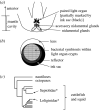Housing microbial symbionts: evolutionary origins and diversification of symbiotic organs in animals
- PMID: 32772661
- PMCID: PMC7435165
- DOI: 10.1098/rstb.2019.0603
Housing microbial symbionts: evolutionary origins and diversification of symbiotic organs in animals
Abstract
In many animal hosts, microbial symbionts are housed within specialized structures known as symbiotic organs, but the evolutionary origins of these structures have rarely been investigated. Here, I adopt an evolutionary developmental (evo-devo) approach, specifically to apply knowledge of the development of symbiotic organs to gain insights into their evolutionary origins and diversification. In particular, host genetic changes associated with evolution of symbiotic organs can be inferred from studies to identify the host genes that orchestrate the development of symbiotic organs, recognizing that microbial products may also play a key role in triggering the developmental programme in some associations. These studies may also reveal whether higher animal taxonomic groups (order, class, phylum, etc.) possess a common genetic regulatory network for symbiosis that is latent in taxa lacking symbiotic organs, and activated at the origination of symbiosis in different host lineages. In this way, apparent instances of convergent evolution of symbiotic organs may be homologous in terms of a common genetic blueprint for symbiosis. Advances in genetic technologies, including reverse genetic tools and genome editing, will facilitate the application of evo-devo approaches to investigate the evolution of symbiotic organs in animals. This article is part of the theme issue 'The role of the microbiome in host evolution'.
Keywords: bacteriome; light organ; symbiosis; symbiotic organ; trophosome.
Conflict of interest statement
I declare I have no competing interests.
Figures


Similar articles
-
Evolution of animal immunity in the light of beneficial symbioses.Philos Trans R Soc Lond B Biol Sci. 2020 Sep 28;375(1808):20190601. doi: 10.1098/rstb.2019.0601. Epub 2020 Aug 10. Philos Trans R Soc Lond B Biol Sci. 2020. PMID: 32772666 Free PMC article. Review.
-
Evolutionary Dynamics of Host Organs for Microbial Symbiosis in Tortoise Leaf Beetles (Coleoptera: Chrysomelidae: Cassidinae).mBio. 2022 Feb 22;13(1):e0369121. doi: 10.1128/mbio.03691-21. Epub 2022 Jan 25. mBio. 2022. PMID: 35073753 Free PMC article.
-
Pathogen resistance may be the principal evolutionary advantage provided by the microbiome.Philos Trans R Soc Lond B Biol Sci. 2020 Sep 28;375(1808):20190592. doi: 10.1098/rstb.2019.0592. Epub 2020 Aug 10. Philos Trans R Soc Lond B Biol Sci. 2020. PMID: 32772671 Free PMC article.
-
In the beginning: egg-microbe interactions and consequences for animal hosts.Philos Trans R Soc Lond B Biol Sci. 2020 Sep 28;375(1808):20190593. doi: 10.1098/rstb.2019.0593. Epub 2020 Aug 10. Philos Trans R Soc Lond B Biol Sci. 2020. PMID: 32772674 Free PMC article. Review.
-
Eco-Evo-Devo: developmental symbiosis and developmental plasticity as evolutionary agents.Nat Rev Genet. 2015 Oct;16(10):611-22. doi: 10.1038/nrg3982. Epub 2015 Sep 15. Nat Rev Genet. 2015. PMID: 26370902 Review.
Cited by
-
Electron microscopy reveals novel external specialized organs housing bacteria in eagle ray tapeworms.PLoS One. 2021 Jan 22;16(1):e0244586. doi: 10.1371/journal.pone.0244586. eCollection 2021. PLoS One. 2021. PMID: 33481793 Free PMC article.
-
Microbial Community Dynamics in Natural Drosophila melanogaster Populations Across Seasons.Environ Microbiol. 2025 Jun;27(6):e70104. doi: 10.1111/1462-2920.70104. Environ Microbiol. 2025. PMID: 40456535 Free PMC article.
-
The role of animal hosts in shaping gut microbiome variation.Philos Trans R Soc Lond B Biol Sci. 2024 May 6;379(1901):20230071. doi: 10.1098/rstb.2023.0071. Epub 2024 Mar 18. Philos Trans R Soc Lond B Biol Sci. 2024. PMID: 38497257 Free PMC article. Review.
-
Ixodes ricinus ticks have a functional association with Midichloria mitochondrii.Front Cell Infect Microbiol. 2023 Jan 9;12:1081666. doi: 10.3389/fcimb.2022.1081666. eCollection 2022. Front Cell Infect Microbiol. 2023. PMID: 36699720 Free PMC article.
-
Environmental microbiomes drive chemotactile sensation in octopus.Cell. 2025 Jun 9:S0092-8674(25)00620-8. doi: 10.1016/j.cell.2025.05.033. Online ahead of print. Cell. 2025. PMID: 40532695
References
-
- Montgomery MK, McFall-Ngai MJ. 1992. The muscle-derived lens of a squid bioluminescent organ is biochemically convergent with the ocular lens. J. Biol. Chem. 267, 20 999–21 003. - PubMed
Publication types
MeSH terms
LinkOut - more resources
Full Text Sources

